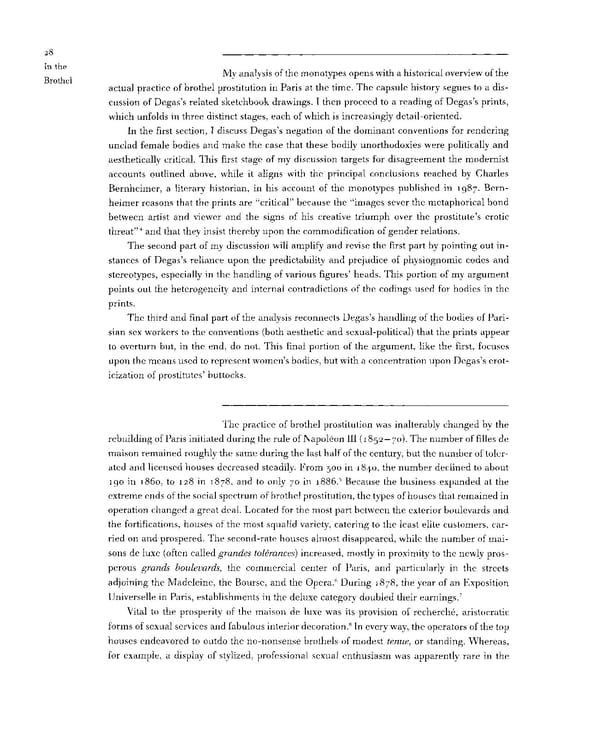28 In the My analysis of the monotypes opens with a historical overview of the Brothel actual practice of brothel prostitution in Paris at the time. The capsule history segues to a dis- cussion of Degas's related sketchbook drawings. I then proceed to a reading of Degas's prints, which unfolds in three distinct stages, each of which is increasingly detail-oriented. In the first section, I discuss Degas's negation of the dominant conventions for rendering unclad female bodies and make the case that these bodily unorthodoxies were politically and aesthetically critical. This first stage of my discussion targets for disagreement the modernist accounts outlined above, while it aligns with the principal conclusions reached by Charles Bernheimer, a literary historian, in his account of the monotypes published in 1987. Bern- heimer reasons that the prints are "critical" because the "images sever the metaphorical bond between artist and viewer and the signs of his creative triumph over the prostitute's erotic threat"4 and that they insist thereby upon the commodification of gender relations. The second part of my discussion will amplify and revise the first part by pointing out in- stances of Degas's reliance upon the predictability and prejudice of physiognomic codes and stereotypes, especially in the handling of various figures' heads. This portion of my argument points out the heterogeneity and internal contradictions of the codings used for bodies in the prints. The third and final part of the analysis reconnects Degas's handling of the bodies of Pari- sian sex workers to the conventions (both aesthetic and sexual-political) that the prints appear to overturn but, in the end, do not. This final portion of the argument, like the first, focuses upon the means used to represent women's bodies, but with a concentration upon Degas's erot- icization of prostitutes' buttocks. The practice of brothel prostitution was inalterably changed by the rebuilding of Paris initiated during the rule of Napoleon III (i 852 — 70). The number of filles de maison remained roughly the same during the last half of the century, but the number of toler- ated and licensed houses decreased steadily. From 300 in 1840, the number declined to about 190 in 1860, to 128 in 1878, and to only 70 in i886.5 Because the business expanded at the extreme ends of the social spectrum of brothel prostitution, the types of houses that remained in operation changed a great deal. Located for the most part between the exterior boulevards and the fortifications, houses of the most squalid variety, catering to the least elite customers, car- ried on and prospered. The second-rate houses almost disappeared, while the number of mai- sons de luxe (often called grandes tolerances) increased, mostly in proximity to the newly pros- perous grands boulevards, the commercial center of Paris, and particularly in the streets adjoining the Madeleine, the Bourse, and the Opera.6 During 1878, the year of an Exposition 7 Universelle in Paris, establishments in the deluxe category doubled their earnings. Vital to the prosperity of the maison de luxe was its provision of recherche, aristocratic 8 forms of sexual services and fabulous interior decoration. In every way, the operators of the top houses endeavored to outdo the no-nonsense brothels of modest tenue, or standing. Whereas, for example, a display of stylized, professional sexual enthusiasm was apparently rare in the
 Prostitution & Impressionists Page 48 Page 50
Prostitution & Impressionists Page 48 Page 50